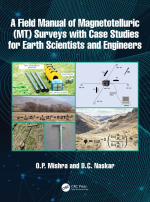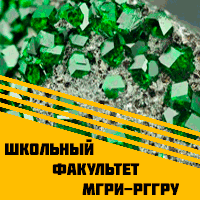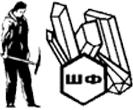Добрый день, Коллеги. Важное сообщение, просьба принять участие. Музей Ферсмана ищет помощь для реставрационных работ в помещении. Подробности по ссылке
A field manual of magnetotelluric (MT). Surveys with case studies for earth scientists and engineers / Практическое руководство по магнитотеллурике (МТ). Обзоры с практическими примерами для ученых-геологов и инженеров
Geophysical methods play a vital role in exploring both the Earth’s surface and its subsurface, addressing complex challenges across the lithosphere, atmosphere, hydrosphere, and cryosphere. Recent advancements in observational systems and computational techniques have significantly enhanced the effectiveness of these methods. Nonetheless, geoscientists continue to face the challenge of accurately detecting deep‑seated structures by estimating the physical parameters of different subsurface layers. Selecting the appropriate geophysical method and skilfully interpreting the data are vital components for the success of any geophysical survey. Moreover, the inherent non‑linearity of geophysical problems often results in non‑unique interpretations. To mitigate this issue, experts advocate for the integration of multiple geophysical methods, as combining various data sets tends to yield more reliable results. Among these methods, magnetotelluric (MT) techniques are particularly noteworthy due to their capacity to probe deep structures, especially when used alongside passive earthquake seismic tomography.
This book, A Field Manual of Magnetotelluric (MT)SurveyswithCase StudiesforEarth Scientists andEngineers, serves as an extensive guide to both the theoretical and practical dimensions of MT geophysics, grounded in the principles of electromagnetic wave propagation through subsurface media. Comprising 18 comprehensive chapters, this book offers in‑depth insights into MT methods, instrumentation, and applications. It provides lucid explanations of the physical principles underlying the method, along with step‑by‑step derivations of essential equations and illustrative figures to enhance the understanding of geoscientific challenges.
Furthermore, this book delves into the diverse applications of MT data, extending across fields such as oil and gas exploration, mineral prospecting, geothermal studies, groundwater exploration, engineering, archaeology, and environmental sciences. Beyond this technical content, this book highlights the requisite skills for various professionals – including earth scientists, engineers, archaeologists, and planners – who can effectively utilize the MT method in their respective fields. It is a remarkable resource catering to both novices and seasoned geophysicists, offering practical insights into survey design, data acquisition, processing, and interpretation. This book is enriched with case studies from various global regions, showcasing the wide‑ranging applicability of MT surveys in tackling complex geological and environmental challenges. The authors have meticulously addressed these issues, aiming to provide plausible solutions to diverse geoscientific problems. I extend my heartfelt congratulations to the authors for their significant scientific and academic contributions that greatly benefit earth scientists, engineers, and related pro‑fessionals. A special acknowledgement is due to Taylor & Francis Group of Publishers (CRC Press) for bringing for‑ward this outstanding work. This book stands as a valuable reference for students, researchers, and professionals involved in analogous geophysical fields of exploration. It also aids in offering supportive interpretations of diverse geophysical data sets. <...>




